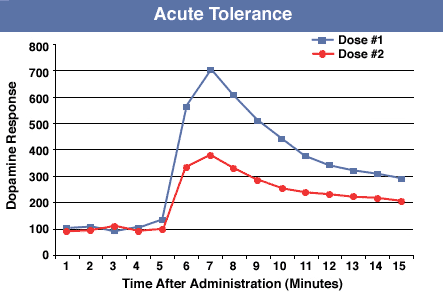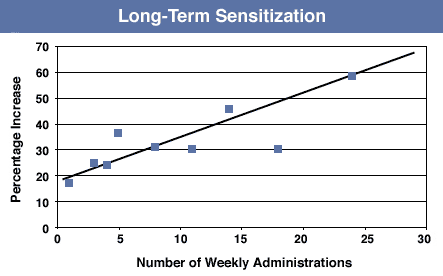|
A major goal of drug abuse research is to determine how voluntary drug use turns into compulsive drug use and addiction. A recent NIDA-supported study sheds light on drug-induced brain changes that may play an important role in this process. The study, conducted in rhesus monkeys, found that even a single low dose of cocaine reduced the brain's response to an identical dose of the drug taken later in the same day. Conversely, weekly exposure to low doses of cocaine made the monkeys' brains progressively more sensitive to the drug. These findings suggest that even occasional cocaine use can alter brain function in ways that may put voluntary users at increased risk of addiction.
|
"This rapid development of tolerance to cocaine's effects could underlie the repeated consumption of escalating doses of the drug that is typical of human cocaine binge sessions."
|
"Perhaps the most striking aspect of this study is the relatively low drug exposure-in each session and cumulatively over the course of the study-that resulted in progressive changes in brain response," says Dr. Charles Bradberry of Yale University School of Medicine in West Haven, Connecticut, who conducted the study. "Previous research in rats indicates that these changes in brain function are essentially permanent and may contribute to cocaine use becoming compulsive," he says. Characteristic patterns of human cocaine consumption in which cocaine is taken repeatedly can result in much higher levels of exposure and could lead to more pronounced changes in brain function, Dr. Bradberry adds.
The study assessed changes in brain function in four rhesus monkeys that were permitted to take a maximum of two doses of 0.5 mg of cocaine per kilogram of their body weight once a week for 6 months. A previous study conducted by Dr. Bradberry indicated that the 0.5 mg/kg dose produces blood levels of cocaine in the monkeys that are equivalent to those found in humans who experience euphoria when given cocaine in laboratory settings. The monkeys self-administered each dose by pressing a lever when a light indicated that cocaine was available. The weekly self-administration of low doses of cocaine was designed to simulate human patterns of weekend cocaine use.
 Acute Tolerance - Exposure to a single low dose of cocaine made the monkeys' brains less responsive to a subsequent dose of the drug taken shortly thereafter, a phenomenon called acute tolerance. This illustration shows extracellular dopamine levels in a monkey's brain after it has self-administered two identical doses of cocaine. The second dose, taken after the effects of the first dose wore off, produced lower levels of dopamine. |
Each week, the researchers measured extracellular levels of dopamine in a region of the monkeys' brains that corresponds to the limbic system in human brains. Cocaine-induced dopamine increases in this region are thought to trigger euphoria and play a significant role in cocaine abuse and addiction.
Short-Term Brain Changes
Within each weekly session, the researchers measured the monkeys' extracellular dopamine levels after the initial dose of cocaine. When the monkeys' extracellular dopamine returned to pre-cocaine levels, the researchers allowed the monkeys to administer the second dose of the drug. The dopamine level did not rise as much following the second dose. This phenomenon, where exposure to a drug makes the brain less responsive to a subsequent exposure shortly thereafter, is called acute tolerance.
"This rapid development of tolerance to cocaine's effects could underlie the repeated consumption of escalating doses of the drug that is typical of human cocaine binge sessions," Dr. Bradberry says. "Research we are conducting now suggests that this acute tolerance may be important in regulating how much cocaine someone takes in a given session." Instead of limiting the monkeys' cocaine intake, the new research permits the animals to continue to infuse cocaine after the first two doses. "Animals that show the most tolerance will take as much cocaine as they can as soon as it is available," Dr. Bradberry says. "Animals that do not show as much tolerance don't take as much."
 Long-Term Sensitization - Modest weekly exposure to cocaine gradually made the monkeys' brains more responsive to the drug, a phenomenon called neurochemical sensitization. This illustration shows weekly changes in extracellular dopamine levels in a monkey's brain after it has taken the first dose of cocaine in each session. In later weeks, the same dose of cocaine produces progressively higher levels of dopamine than it did in earlier weeks. |
Long-Term Brain Changes
The modest doses of cocaine once a week also caused long-lasting changes in the way the monkeys' brains responded to the drug over time. As the study progressed, the same 0.5 mg/kg dose of cocaine that began each weekly session produced increasingly greater changes in the levels of extracellular dopamine in the monkeys' brains than it did at the beginning of the study.
"This finding demonstrates for the first time that when primates are exposed to a pattern of occasional cocaine use, they develop neurochemical sensitization, a phenomenon marked by an increase in brain response following repeated administration of a drug," says Dr. Jane Acri of NIDA's Division of Treatment Research and Development.
"Our knowledge of exactly how people become addicted to drugs is in its early stages," Dr. Acri says. "Now, we are trying to elucidate the factors involved in the transition from drug use to addiction. While it is still unclear how sensitization affects this transition, we think it may play a role. Demonstrating these initial changes in animals is a very big step in understanding this process from a biological point of view."
Source
Bradberry, C.W. Acute and chronic dopamine dynamics in a nonhuman primate model of recreational cocaine use. Journal of Neuroscience 20(18):7109-7115, 2000. [Abstract]; [Full Text]
|